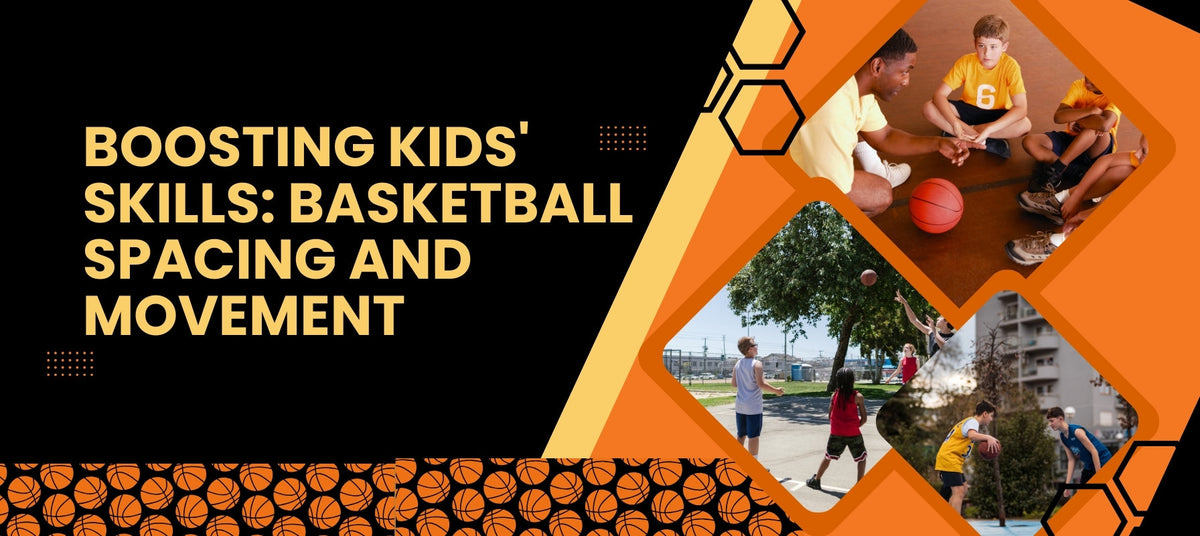
Boosting Kids' Skills: Basketball Spacing and Movement
|
|
Tiempo de lectura 5 min
|
|
Tiempo de lectura 5 min
As parents, we want to see our young athletes excel in whatever sport they choose, and for those of us with kids who love basketball, 'basketball spacing and movement' are two essential concepts for them to grasp. Mastering these fundamentals doesn't just make them stronger players – it can significantly impact their team's overall success.
But sometimes, understanding offensive spacing and player movement can seem confusing and challenging to teach, even for seasoned coaches and experienced players. I’ve been there. In this post, we will cover the ins and outs of effective spacing and movement, using simple language, clear examples, and even some proven drills and coaching strategies. We will also dive deep into basketball spacing drills and other basketball tips to improve your team's basketball offense.
Think of a basketball court as a stage – if all the actors crowd into one corner, the play will be awkward and chaotic. This is how bad spacing can impact a basketball game and limit scoring opportunities. Let's explore why great spacing is key to a successful basketball offense.
With good court spacing, players have more open passing lanes. Players spread out, giving the ball-handler more and better passing options. A packed court makes it much easier for defenders to clog passing lanes and force turnovers.
Imagine you are the point guard, and you see a gap in the defense. If your teammates are spaced well, you have a clear path to drive toward the basket. Good spacing prevents your defender from getting help from a teammate who is out of position. This allows for more opportunities for your offensive team to dribble penetrate the basket.
When players are appropriately spaced, it creates better shot selections, often leading to more open shots for the offensive team. This is especially important for those aspiring three-point shooters. Good spacing forces the defense to cover the entire court, increasing the chance of a teammate getting open for a shot. This will also create driving lanes for the ball handler as the defensive players spread out to cover the three-point arc.
While understanding the spacing concept is vital, true mastery of basketball requires purposeful movement. It's not merely about running around; it's about strategic positioning and well-timed cuts to create scoring opportunities.
Good screens are as essential as crisp passes and clutch shots in basketball. It’s all about teamwork. Players use screens by positioning themselves to block a defender, allowing their teammate to get open for a shot or drive to the basket.
This can also give the player setting the screen an opportunity to roll to the basket or pop out to the three-point line. Practicing different screen techniques and timing is crucial.
Ever watched a basketball game where it seemed like the players were reading each other’s minds? This synergy stems from excellent communication. Encourage players to talk to each other on the court. By calling for screens, passes, and cuts, confusion lessens and plays run smoother.
Good communication enables players to get into the proper triple-threat position when they catch the ball. This positioning offers more offensive options, such as shooting, passing, or driving to the basket.
There are a lot of helpful coaching tools out there for developing team strategy. Some great ones to check out can be found on Sportplan. These coaching tips and basketball drills are designed to enhance your team's performance.
This is an example of a basketball spacing drill derived from Spacing & Relocation by Kelvin Sampson.
This simple drill helps players understand court positioning and basic passing. This drill will teach players the importance of spacing and where they should be on the court set.
This classic basketball drill emphasizes moving with the ball, passing, and maintaining spacing during a fast break.
In its simplest terms, spacing refers to how players are spread out across the court, ideally maintaining an appropriate distance from one another. This creates better-passing lanes, driving lanes, and shot opportunities.
Drilling different offensive sets like the 5-Out or the 4-Out 1-In are effective ways to practice proper spacing. Simple drills like the 5-Out Passing Drill mentioned above are incredibly effective in emphasizing and improving court positioning.
'Spacing the Floor' is a common basketball term meaning that offensive players are strategically positioned to create better passing lanes, and driving opportunities and improve shot selection. A well-spaced floor makes it more challenging for the defense to guard effectively.
Mastering 'basketball spacing and movement' can seem daunting initially, but by consistently applying these techniques and practicing with purpose, players and teams can elevate their game. And always, have fun. This should never feel like a chore but an adventure that encourages teamwork, sportsmanship, and of course, skill development in our budding basketball players.
For more great insights on spacing and movement strategies, check out resources from Radius Athletics. Learn more on #FindUseCreate. Coaches looking for in-depth information on offense strategies can benefit from Radius Athletics finding, using, and creating resources.
Teams can greatly benefit from proper "basketball spacing and movement" concepts to elevate their games. Understanding why and how to create and use space is only part of the equation; equally important is pairing these with purposeful, deliberate movement.
Basketball Spacing. Basketball Spacing. Basketball Spacing. Basketball Spacing. Basketball Spacing. Basketball Spacing. Basketball Spacing. Basketball Spacing. Basketball Spacing. Basketball Spacing. Basketball Spacing. Basketball Spacing. Basketball Spacing.Basketball Spacing. Basketball Spacing. Basketball Spacing. Basketball Spacing. Basketball Spacing. Basketball Spacing. Basketball Spacing. Basketball Spacing.
Este sitio requiere cookies para proporcionar todas sus funciones.